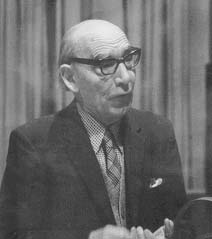Bohumil Trnka
Czech scholar Bohumil Trnka (3.6.1895 in Kletečná – 14.2.1984 in Prague), professor of English and older English literature at the Faculty of Arts, Charles University, Prague, was one of the founders of the Prague Linguistic Circle (1926), its first secretary, and one of the most important representatives of the Prague Linguistic School.
The representative English-translated selection of Trnka’s fifty contributions to English, Czech and general linguistics, written in the years 1928-1978, was published by the Czech anglicist Fried (Trnka 1982).
This comprehensive volume covers all main fields of his linguistic research: general linguistics, synchronic phonology, historical linguistics (diachronic phonology and morphology), synchronic morphology, syntax and style, and last but not least, statistical linguistics. Trnka’s studies are a significant testimony to the development of linguistic thought in the twentieth century.
Below we would like to remember that one of Trnka’s favourite scientific topics was phonology: As early as in 1935 he published the first systematic phonological description of Modern English (which was – 31 years later – also published in Japan, 1966); he concentrated on the qualitative as well as quantitative analysis (functional load) of phonemes, both in the language system and in speech. In his research, he particularly emphasized one point: while the presence vs. the absence of an element in a language system is a matter of quality, the functional load of an element is a quantitative complementary feature. Also Trnka’s scientific contribution to structural and functional morphology, as well as to other levels (plans, subsys-tems) of language, to the theory of the linguistic sign, to the historical evolution of language, etc. is well-known.
Trnka was the author of the most comprehensive programmatic integration of quantitative studies in the Prague structuralist theory of language. He believed in the existence of general quantitative laws which govern the structure of all languages, and he considered attempts to formulate them as a major task of future quantitative linguistics. On the 6th International Linguistic Congress in Paris (1948), Trnka was one of the nine elected members of the committee for linguistic statistics, which was established at the congress to promote quantitative research. As the secretary of this committee, he began to organize the work in accordance with the recommendations of the Congress, by starting to compile „a provisional bibliography“ of „works devoted specially to the statistical method in linguistic matters“ for early publication with financial aid provided by UNESCO. This bibliography is the first bibliography of quantitative linguistics ever (Trnka 1950a): it includes 235 items divided into ten sections:
I. General works on linguistic statistics.
II. Frequency of phonemes. General laws of phonemic frequency.
III. Frequency of words and general laws of their distribution.
IV. Frequency dictionaries and frequency word counts for the purpose of learning modern languages.
V. Morphological, syntactic, metrical and semantic studies based on counts.
VI. Concordances and word frequency counts in vocabularies referring to individual authors.
VII. Statistical studies preparatory to the construction of auxiliary languages or to the rationalization of spelling. Basic English.
VIII. Statistical study preparatory to the construction of shorthand and typewriter systems. Telephone conversations.
IX. The growth of the vocabulary of children’s speech . Schizophrenic language.
X. Statistical studies referring to problems of historical grammar and classification of languages.
It is worth mentioning that among those who collaborated with Trnka on the bibliography was another member of the committee for quantitative linguistics, G.K. Zipf. Trnka also re-viewed Zipf’s studies: he was the first to acquaint Czech linguists with Zipf’s work (1950b). Trnka pointed out the independence of and the differences between the starting points and aims of the Prague School's and Zipf’s quantitative researches. He was certainly not wrong when he highly praised Zipf’s work in his English review on the one hand, expressing his conviction that “it will not fail to influence the linguistic thought of today” (1950: 5), nor was he wrong when, on the other hand, he stressed that Zipf’s laws were only partially applicable, and when he demanded that they be revised. He accurately described Zipf’s contribution showing the advantages of a statistical method compared with qualitative analysis in the sense that statistical analysis “is being able to afford to neglect the narrow limits of one language and to concentrate on linguistic problems of a general character”.
Comparing the picture of the modest title page of Trnka‘s bibliography with big bibliographies of quantitative linguistics compiled later on (either accessible in print or on the internet now), we can see and appreciate the enormous development of the field of quantitative studies during last decades.
Literatur
- Trnka, Bohumil. 1935. A Phonological Analysis of PresentDay Standard English. Praha: Universita Karlova.
- Trnka, Bohumil. 1950a. A Tentative Bibliography. Utrecht etc.: Publication of the Committee of Linguistic Statistics.
- Trnka, Bohumil. 1950b. Review of: Zipf, G. K.. The psychobiology of language; Human behavior and the principle of least effort. In: Časopis pro moderní filologii 33. 3-5.
- Trnka, Bohumil. 1982. Selected papers in structural linguistics. (Ed. V. Fried.). Berlin: Mouton.
Quelle
Ludmila Uhlířová: Glottometrics 6, 2003, 103-106
